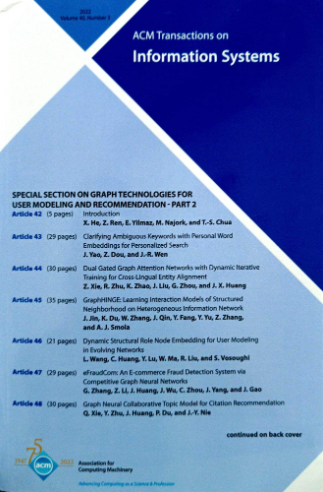面向人气分布转移的鲁棒协同过滤
IF 9.1
2区 计算机科学
Q1 COMPUTER SCIENCE, INFORMATION SYSTEMS
引用次数: 1
摘要
在领先的协同过滤(CF)模型中,用户和项目的表示倾向于学习训练数据中的流行偏差作为快捷方式。流行度捷径技巧对分布内(ID)性能很好,但不适用于分布外(OOD)数据,即当测试数据的流行度分布与训练数据的流行度分布相反时。为了缩小差距,去偏策略试图评估捷径度并从表征中减轻它们。但存在两个不足:(1)大多数策略在测量快捷度时,仅使用单一方面的统计度量(即项目对项目的频率和用户对用户方面的频率),未能适应用户-项目对的构成程度;(2)在缓解捷径时,许多策略都假设测试分布是事先已知的。这导致低质量的无偏见表示。更糟糕的是,这些策略以牺牲ID性能来实现OOD的通用性。在这项工作中,我们提出了一个简单而有效的去偏策略,PopGo,它量化和减少了交互方面的流行捷径,而不需要对测试数据进行任何假设。它首先学习一个快捷模型,该模型根据用户-物品对的流行度表示生成快捷度。然后,它通过调整预测与交互的快捷度来训练CF模型。通过对PopGo的因果和信息理论的观察,我们可以证明为什么它鼓励CF模型捕捉关键的流行不可知论特征,而将虚假的流行相关模式排除在外。我们使用PopGo对四个基准数据集上的两个高性能CF模型(MF, LightGCN)进行了比较。在ID和OOD测试集上,PopGo比最先进的去偏策略(例如DICE, MACR)都取得了显著的进步。本文章由计算机程序翻译,如有差异,请以英文原文为准。
Robust Collaborative Filtering to Popularity Distribution Shift
In leading collaborative filtering (CF) models, representations of users and items are prone to learn popularity bias in the training data as shortcuts. The popularity shortcut tricks are good for in-distribution (ID) performance but poorly generalized to out-of-distribution (OOD) data, i.e., when popularity distribution of test data shifts w.r.t. the training one. To close the gap, debiasing strategies try to assess the shortcut degrees and mitigate them from the representations. However, there exist two deficiencies: (1) when measuring the shortcut degrees, most strategies only use statistical metrics on a single aspect (i.e., item frequency on item and user frequency on user aspect), failing to accommodate the compositional degree of a user-item pair; (2) when mitigating shortcuts, many strategies assume that the test distribution is known in advance. This results in low-quality debiased representations. Worse still, these strategies achieve OOD generalizability with a sacrifice on ID performance. In this work, we present a simple yet effective debiasing strategy, PopGo, which quantifies and reduces the interaction-wise popularity shortcut without any assumptions on the test data. It first learns a shortcut model, which yields a shortcut degree of a user-item pair based on their popularity representations. Then, it trains the CF model by adjusting the predictions with the interaction-wise shortcut degrees. By taking both causal- and information-theoretical looks at PopGo, we can justify why it encourages the CF model to capture the critical popularity-agnostic features while leaving the spurious popularity-relevant patterns out. We use PopGo to debias two high-performing CF models (MF, LightGCN) on four benchmark datasets. On both ID and OOD test sets, PopGo achieves significant gains over the state-of-the-art debiasing strategies (e.g., DICE, MACR).
求助全文
通过发布文献求助,成功后即可免费获取论文全文。
去求助
来源期刊

ACM Transactions on Information Systems
工程技术-计算机:信息系统
CiteScore
9.40
自引率
14.30%
发文量
165
审稿时长
>12 weeks
期刊介绍:
The ACM Transactions on Information Systems (TOIS) publishes papers on information retrieval (such as search engines, recommender systems) that contain:
new principled information retrieval models or algorithms with sound empirical validation;
observational, experimental and/or theoretical studies yielding new insights into information retrieval or information seeking;
accounts of applications of existing information retrieval techniques that shed light on the strengths and weaknesses of the techniques;
formalization of new information retrieval or information seeking tasks and of methods for evaluating the performance on those tasks;
development of content (text, image, speech, video, etc) analysis methods to support information retrieval and information seeking;
development of computational models of user information preferences and interaction behaviors;
creation and analysis of evaluation methodologies for information retrieval and information seeking; or
surveys of existing work that propose a significant synthesis.
The information retrieval scope of ACM Transactions on Information Systems (TOIS) appeals to industry practitioners for its wealth of creative ideas, and to academic researchers for its descriptions of their colleagues'' work.
 求助内容:
求助内容: 应助结果提醒方式:
应助结果提醒方式:


